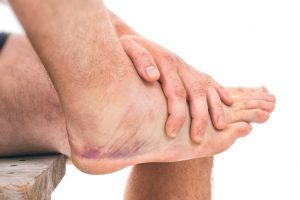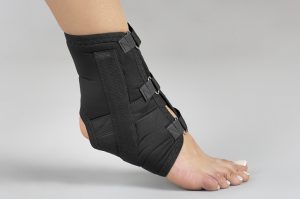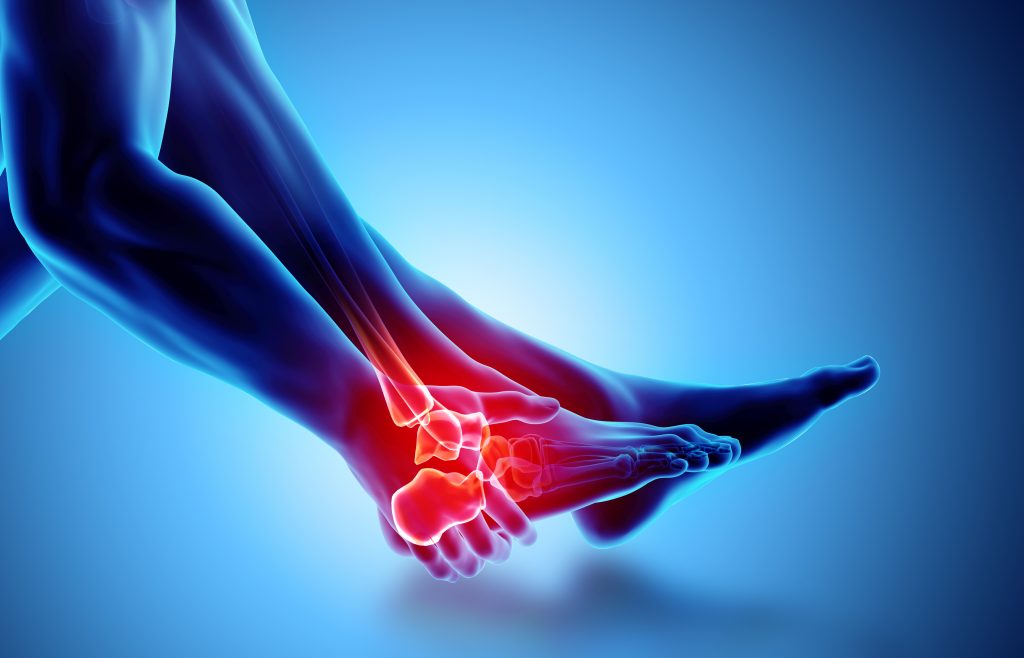70% of sports injuries are caused by an ankle sprain (Geier, 2019). Recurrent ankle sprains are widespread in runners. They can sometimes leave people unable to walk. This post covers what they are and how to spot them. We then look at the treatment and prevention of recurrent ankle sprains.

What is the Difference Between a Sprain and a Strain?
Most people have heard the terms sprain and strain, but do not know the difference between them.
A strain refers to damage to the muscle or tendon. Acute strains are caused by trauma, while chronic strains are usually from overuse. However, a sprain is damage to the ligament. They can become overstretched, and can also tear.
The ankle is one of the most common areas to sprain. Like strains, they sometimes become chronic. Over time, recurrent ankle sprains can develop.
Just being mindful of the reasons they happen can help you avoid spraining your ankle.
How Ankle Sprains Occur
You can sprain your ankle in many ways, whether you’re competing in a high-level sport or walking down the road. To prevent recurrent ankle sprains, it’s helpful to know how they happen.
Often people are prone to ankle sprains are due to:
- Weak muscle groups
- Stiff ankles/joints
- Lack of awareness of the body and movement
All three of these things could contribute to a recurrent ankle sprain. When running, or doing any other type of exercise for that matter, be mindful of how your body is moving. If you’re aware of stiff joints or ankles or have weak muscle groups, prevention is better than cure. It’s essential to work on those areas if you want to avoid sprains. Add preventative rehabilitation and muscle strengthening exercises to your fitness regime.

Common Types of Ankle Sprain when Running
Ankle sprains are very common in runners. In fact, 28% of all running injuries are to do with the foot and ankle.
Lateral ankle injuries account for over half of these. They make up one percent of all sports injuries that present at clinics. (Davis, 2019). They occur when the ankle rolls outwards, which is common when running. This results in a sprain to the anterior talar fibular ligament (ATFL) (Van De Wees, 2017). Inversion of the ankle ligaments is also a common type of sprain. They make up around 25% of all musculoskeletal injuries (Dijk, 2002).
Recurrent Ankle Sprains in Athletes: Overuse Syndrome
When it comes to athletes, recurrent ankle sprains are often caused by using the ankle too much. This a sign of overuse syndrome, and it is prevalent amongst professional runners.
Adolescent runners are especially prone to developing the syndrome. The demands of the sport play a significant role in this. Not only is running taxing on the body, but there are other pressures from family and coaches (Maestro et al., 2016).
The factors that usually contribute to overuse syndrome fall under two main categories. The first category is intrinsic. Intrinsic factors include gender, development, growth, and anatomical changes. There are also extrinsic factors such as footwear, running surface, and training errors (O Mayr et al., 2016).

If you run professionally, you are at an increased risk of a recurrent ankle sprain. However, those who run as a hobby are also susceptible. You can increase your risk by running too frequently without proper rest and recovery time.
If you have pain in your ankles and feet, this could be the signs of an ankle sprain. Without treatment, your ankle is weakened. This is when recurrent ankle sprains start to happen. So, it’s crucial you spot the signs before it’s too late!
Symptoms of a Sprained Ankle
To avoid developing a recurrent ankle sprain, it’s important to spot it early. If you have any of these symptoms, you might have a sprained ankle:
- You have pain or weakness around your ankle.
- You notice swelling around it.
- There is bruising around it.
- You can’t put weight through the ankle or use it normally.
- You have intense muscle cramps or spasms.
If pain and swelling aren’t subsiding, this could be more serious. If you notice ankle pain getting worse or your temperature rises, you should seek medical advice. Contact your GP, 111, or go to A&E. If you heard a pop, crack or snap, it’s always best to get it checked. This is also true if you notice any deformities in your ankle or the site of injury is cold. If this is the case, head to a minor injury unit for an x-ray or review by a doctor (NHS, 2018).
Otherwise, you can generally treat an ankle sprain yourself.

Treatment for Ankle Sprains
Proper treatment is essential for helping you to heal, avoiding recurrent ankle sprains. Knowing the stages of soft tissue healing helps in understanding the right form of treatment. If you can identify the stage of soft tissue healing, this will inform how you treat your injury.
The Stages of Soft Tissue Healing
There are three main stages of soft tissue plus a smaller phase at the start of the tissue healing process.
Before the initial stage is the bleeding phase. This starts immediately after the injury. The bleeding phase is short, usually between 6-8 hours. But it can sometimes extend to 24 hours. After this, there are three stages of soft tissue healing:
1. The Inflammatory Stage
Inflammation occurs to stop the bleeding in the previous phase. The blood supply to the damaged area increases, which causes redness and swelling.
This stage starts fairly quickly. It usually begins within 6-8 hours after the injury, reaching its peak within 1-3 days. It’s often over in around 3 weeks. During the inflammatory stage, you might also experience stiffness in the area.

2. The Proliferation Stage
During this phase, the body produces collagen to form scar tissue. This usually starts between 24-48 hours after the sprain happens. But it is sometimes 2-3 weeks before the majority of the scar tissue is created.
3. The Remodelling Stage
This usually starts around the peak of the proliferation phase. It can last from 6 weeks to two years! During this phase, a scar is produced. This is similar to the scar tissue in the previous stage. However, it is a more permanent fixture (Orsted et al., 2011).
These stages are essential to bear in mind when it comes to recurrent ankle sprains. If you sprain your ankle, and it does not fully heal, it is weaker. This makes it more prone to further injuries.
Correct Treatment for Each Stage
Now we understand what the stages of soft tissue healing are, we will move on to the best type of treatment for each. Correct treatment prevents recurrent ankle sprains from happening.
1. The Inflammatory Stage
When looking at this stage, the basic principle to follow is RICE. This helps alleviate the swelling.
Rest. In a runner’s case, stop running and give your body time to recover.
Ice. Wrap your ice in a towel or damp cloth. Apply to the area for 15-20 minutes every couple of hours.
Compression. Use a tubi-grip around the ankle to compress the area.
Elevation. When resting, keep the ankle above your heart. To do this, rest it on some pillows.
Following RICE will help to stop the ankle from swelling further.
2. The Proliferation Stage
During this stage, the pain decreases. Because of this, many people go back to running or other activity too early. This puts them at risk of recurrent ankle sprains, as it is easy to then re-injure the ankle.

Despite there being less pain, this is the stage when your ankle is at its most vulnerable. This is because the collagen is laid down but in an unorganised manner. During this stage, focus on the range of movement in the ankle. Also, be mindful of joint and scar mobilisation to prevent the build-up of scar tissues.
3. The Remodelling Stage
For some people, this may be as early as 2-3 weeks. But for others, it may be years. How long this takes depends on the grading of tissue damage.
If you are unsure of the severity of the sprain, contact a health care professional. At this stage, you can begin to use the ankle more. It is important to add stress to the tissues as this helps to realign new fibres. This will ensure that they are positioned in a manner to cope with stress the ankle goes through when running. Examples of activities to do at this stage include strength training, using eccentric exercises (Palermo Physiotherapy & Wellness Centre, 2019).
How to Prevent Recurrent Ankle Sprains
We’ve covered how common ankle sprains are, and how debilitating it is when they occur. Thankfully, it is relatively easy to prevent them from reoccurring.
Ankle Support
Many people use ankle supports to help prevent further injury. However, there is a risk here of becoming dependent on ankle support. If the ankle cannot support itself, there’s a high chance of recurrent ankle sprains. This is also damaging from a psychological point of view. People feel that they can’t run without support and lose confidence.

Use support if the ankle feels unstable, but do not wear them every day. Slowly wean yourself off them after some time. This being said, it depends on how severe your injury is. If you have a complete ligament rupture, you may need surgery or short-term bracing to aid recovery (American Academy of Orthopaedic Surgeons, 2016).
Strengthening Exercises
A crucial aspect of preventing recurrent ankle sprains is to ensure that your ankles are strong and flexible. Ensure that you train the muscles that support your ankles, such as the gastrocnemius and soleus. Calf raises with both straight and bent legs will help to work both of those muscle groups. People underestimate the importance of strength training in the whole of the leg. Our body forms a kinetic chain. This means that if one muscle is imbalanced, it can increase your chances of becoming injured in other areas (The Cleveland Clinic Foundation, 2017).
Proprioception Exercises
Proprioception exercises can really help prevent recurrent ankle sprains. These ensure that your ankle is trained to know where it is in space. This type of training isn’t used as much as it should be. It is a massive part of ankle rehabilitation.
Whether or not your ankles are healthy, if you lack proprioception, then injuries quickly reoccur. Spending time on a wobble board or cushion can help improve proprioception in your ankle, knee, and hip. You can start off easy by using both feet. Then, gradually make it harder. Balance on one leg or try some pistol squats (The Cleveland Clinic Foundation, 2017).
Summary
In summary, ankle sprains are very common, especially in the lateral aspect. When you sprain your ankle, you need to rest it, use ice and keep it elevated. Without proper rest and recovery, recurrent ankle sprains can occur.
If you think you’ve sprained your ankle, refer to the stage of soft healing that you are in to treat the injury. However, if your sprain is not getting better or pain is worsening, seek medical help.
To avoid recurrent ankle sprains, ensure you strengthen your surrounding muscles, keep them flexible, and work on proprioception exercises.
Further Reading
If you’re prone to injury when exercising, give this post on injury prevention a read. Another common injury that happens during sport is a rotator cuff injury. This can be as debilitating as an ankle sprain! Read how to avoid and treat rotator cuff injuries here.
